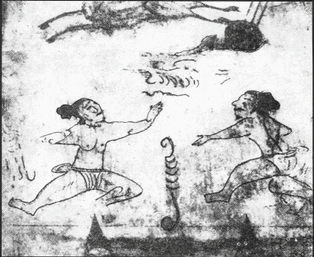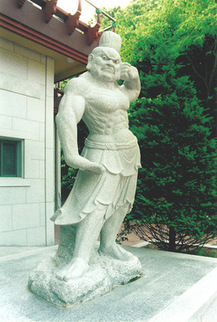The 5 code spirits and 7 tenets of Tang Soo Do
Won Kwa or also known as Won Gwang (541-630),and confusing enough also known as Won Gwang Beop Sa (圓光法士) meaning "Won Gwang Teacher of the Law", was the name of a renowned Buddhist monk, scholar, and teacher of the Silla kingdom during the reign of King Jinpyeong.
His layname was Seol (설 hanja: 薛) or Bak (박 hanja: 朴). Like a great number of other Korean Buddhist monks of the 6th-8th centuries, Won Gwang traveled to China in search of a more thorough grounding in the sacred texts of Buddhism. In 589 Wongwang went to Sui China, where for eleven years he was educated in the major texts of both Hinayana and Mahayana Buddhism.
Won Gwang returned to Silla in 600 and promulgated the Mahayana form of Buddhism. His method was to teach the faith to the common people free of complex jargon and employing common words.
Won Gwang is best known for his "Five Commandments for Secular Life" (세속오계Sesok-ogye 世俗五戒), which later were attributed as a guiding ethos for the Hwarang. These five commandments were to serve as moral guideposts for the Buddhist layperson. They are an interesting fusion of the Buddhist beliefs and strong sense of patriotism that characterized Silla Buddhism. To Won Gwang, viewing Silla as a true Buddha Land and under constant threat from the neighboring kingdoms of Baekje and Goguryeo, the defense of that land and a Buddhist piety were not at all contradictory. These five principles were as follows:
The original translation was:
Loyalty to one's lord (事君以忠; 임금은 충성으로써 섬겨야 한다)
Devotion towards one's parents (事親以孝; 어버이를 효도로써 섬겨야 한다)
Trust among friends (交友以信; 벗은 믿음으로써 사귀어야 한다)
Never retreat in battle (臨戰無退; 전쟁에 임하여 물러나지 아니하여야 한다)
Be selective in the taking of life (殺生有擇; 함부로 살생을 하지 말아야 한다)
The precise dates of Won Gwang‘s life are unknown.
His layname was Seol (설 hanja: 薛) or Bak (박 hanja: 朴). Like a great number of other Korean Buddhist monks of the 6th-8th centuries, Won Gwang traveled to China in search of a more thorough grounding in the sacred texts of Buddhism. In 589 Wongwang went to Sui China, where for eleven years he was educated in the major texts of both Hinayana and Mahayana Buddhism.
Won Gwang returned to Silla in 600 and promulgated the Mahayana form of Buddhism. His method was to teach the faith to the common people free of complex jargon and employing common words.
Won Gwang is best known for his "Five Commandments for Secular Life" (세속오계Sesok-ogye 世俗五戒), which later were attributed as a guiding ethos for the Hwarang. These five commandments were to serve as moral guideposts for the Buddhist layperson. They are an interesting fusion of the Buddhist beliefs and strong sense of patriotism that characterized Silla Buddhism. To Won Gwang, viewing Silla as a true Buddha Land and under constant threat from the neighboring kingdoms of Baekje and Goguryeo, the defense of that land and a Buddhist piety were not at all contradictory. These five principles were as follows:
The original translation was:
Loyalty to one's lord (事君以忠; 임금은 충성으로써 섬겨야 한다)
Devotion towards one's parents (事親以孝; 어버이를 효도로써 섬겨야 한다)
Trust among friends (交友以信; 벗은 믿음으로써 사귀어야 한다)
Never retreat in battle (臨戰無退; 전쟁에 임하여 물러나지 아니하여야 한다)
Be selective in the taking of life (殺生有擇; 함부로 살생을 하지 말아야 한다)
The precise dates of Won Gwang‘s life are unknown.
Won Kwa's biography 13th century , Haedong Goseungjeon.
The Haedong Goseungjeon (translated most commonly as the "Lives of Eminent Korean Monks") was a compilation of mostly Korean Buddhist hagiographies, notably of famous monks from the Three Kingdoms period of Korean history.
It was compiled by the monk Gakhun (각훈, 覺訓) (dates unknown) by order of the Goryeo king Gojong in 1215. Though Gakhun was working in the tradition of Chinese Buddhist historiography (which had a long tradition of compiling lives of eminent monks), as was the case with the compilation of the Samguk Sagi and Samguk Yusa, the composing of the Haedong Goseungjeon was meant to promote native exemplars, in this case of Buddhist piety. It also served to bring prominence and merit to the court that ordered its compilation.
The work, along with the Samguk Sagi and the Samguk Yusa, comprises one of the most important sources for the Three Kingdoms period. The monk Iryeon consulted the work some half a century later when compiling his Samguk Yusa.
It was long thought that the work was lost, until portions of it were rediscovered at a Buddhist temple in Seongju in the early twentieth century. Only two of probably more than ten volumes survive. The extant volumes include biographies of eighteen famous and not–so–famous Buddhist monks from Goguryeo and Silla, as well as India and China. Unfortunately, some of the most famous of Three Kingdoms period Buddhist figures are not included (namely Wonhyo), though they were presumably included in the missing volumes.
Not much is known of the work‘s chief compiler, except that he served as the chief abbot of Yeongtongsa, i.e. the Yeong Tong Temple (영통사, 靈通寺) in the city of Kaesŏng, North Korea, which was then the capital city of Goryeo. His deeds go unrecorded in the Goryeosa (History of Goryeo).
The surviving portion of the Haedong Goseungjeon contains the biographies of the following monks (native place):
Sundo 順道 (unknown; China)
Mangmyeong 亡名 (Goguryeo)
Uiyeon 義淵 (Goguryeo)
Damsi/Tanshi 曇始 (China)
Mālānanda (Xinjiang)
Ado 阿道 (unknown; India?)
Beopgong 法空, a.k.a. King Beopheung of Silla (Silla)
Beop‘un 法雲 (Silla)
Gakdeok 覺德 (Silla)
Ji‘myeong 智明 (Silla)
Wongwang 圓光 (Silla)
Anham 安含 (Silla)
Āryavarman (Silla)
Hye‘eup 惠業 (unknown)
Hyeryun 惠輪, or 慧輪 (Silla)
Hyeon‘gak 玄恪 (Silla)
Hyeon‘yu 玄遊 (Goguryeo)
Hyeontae 玄太 (Silla)
It was compiled by the monk Gakhun (각훈, 覺訓) (dates unknown) by order of the Goryeo king Gojong in 1215. Though Gakhun was working in the tradition of Chinese Buddhist historiography (which had a long tradition of compiling lives of eminent monks), as was the case with the compilation of the Samguk Sagi and Samguk Yusa, the composing of the Haedong Goseungjeon was meant to promote native exemplars, in this case of Buddhist piety. It also served to bring prominence and merit to the court that ordered its compilation.
The work, along with the Samguk Sagi and the Samguk Yusa, comprises one of the most important sources for the Three Kingdoms period. The monk Iryeon consulted the work some half a century later when compiling his Samguk Yusa.
It was long thought that the work was lost, until portions of it were rediscovered at a Buddhist temple in Seongju in the early twentieth century. Only two of probably more than ten volumes survive. The extant volumes include biographies of eighteen famous and not–so–famous Buddhist monks from Goguryeo and Silla, as well as India and China. Unfortunately, some of the most famous of Three Kingdoms period Buddhist figures are not included (namely Wonhyo), though they were presumably included in the missing volumes.
Not much is known of the work‘s chief compiler, except that he served as the chief abbot of Yeongtongsa, i.e. the Yeong Tong Temple (영통사, 靈通寺) in the city of Kaesŏng, North Korea, which was then the capital city of Goryeo. His deeds go unrecorded in the Goryeosa (History of Goryeo).
The surviving portion of the Haedong Goseungjeon contains the biographies of the following monks (native place):
Sundo 順道 (unknown; China)
Mangmyeong 亡名 (Goguryeo)
Uiyeon 義淵 (Goguryeo)
Damsi/Tanshi 曇始 (China)
Mālānanda (Xinjiang)
Ado 阿道 (unknown; India?)
Beopgong 法空, a.k.a. King Beopheung of Silla (Silla)
Beop‘un 法雲 (Silla)
Gakdeok 覺德 (Silla)
Ji‘myeong 智明 (Silla)
Wongwang 圓光 (Silla)
Anham 安含 (Silla)
Āryavarman (Silla)
Hye‘eup 惠業 (unknown)
Hyeryun 惠輪, or 慧輪 (Silla)
Hyeon‘gak 玄恪 (Silla)
Hyeon‘yu 玄遊 (Goguryeo)
Hyeontae 玄太 (Silla)
Student creed
- I intend to develop myself in a positive manner and avoid anything that would reduce my mental growth or my physical health.
- I intend to develop self-discipline, in order to bring out the best in myself and others.
- I intend to use what I learn in class constructively and defensively, to help myself and my fellow man, and never be abusive or offensive.

